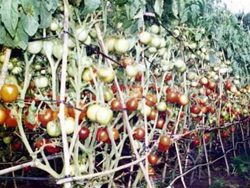In addition to concerns about market access, tomato farmers still carry another worry: the wilt disease caused by the bacterium Ralstonia solanacearum, which strikes every year. However, things have changed now…
 |
|
Heavily fruiting grafted tomatoes, resilient against diseases – Photo: Q.THANH (TTO) |
A technical advancement in combating the bacterial wilt disease in tomatoes, developed by a research team from the Southern Agricultural Science and Technology Institute, could provide farmers with greater peace of mind…
This pathogenic bacterium spreads rapidly and can cause massive plant deaths. Dr. Ngo Quang Vinh, head of the food crop research department at the Southern Agricultural Science and Technology Institute, emphasized that this bacterium has one of the longest lifespans in soil.
Moreover, when it infiltrates the tomato plant’s stem, Ralstonia solanacearum spreads, reproduces, and quickly fills the plant’s vascular system, blocking the pathways that transport nutrients. Consequently, when affected by Ralstonia solanacearum, the plants wilt quickly and may die shortly thereafter.
According to research led by Professor Pham Van Bien, director of the Southern Agricultural Science and Technology Institute, the typical mortality rate for plants affected by Ralstonia solanacearum is between 20-30%, with severe cases resulting in 100% loss.
In countries like Japan, Taiwan, and South Korea, one method to prevent bacterial wilt in tomatoes is to graft the tomato shoots onto the roots of eggplants or other tomato varieties that are disease-resistant and resilient. Scientists believe this is one of the best solutions to alleviate farmers’ concerns about wilt diseases in tomatoes. In Vietnam, Dr. Vinh’s research team is also pursuing this line of study, which began in late 2002…
The aforementioned research team conducted one of the first experiments to evaluate the capability of grafting tomatoes and selecting rootstocks in Ho Chi Minh City, covering an area of 700 square meters in Tan Phu Trung commune, Cu Chi district. This team intentionally set up the experiment in a plot of tomato plants that had suffered 100% mortality due to bacterial wilt.
The experiment utilized six types of eggplants for grafting: EG203, Mui Ne, Kalenda, East-West, along with HW96 tomatoes and ornamental tomatoes. The grafting was done with the local tomato variety from Cu Chi. Another similar experiment was set up in Lien Nghia town, Duc Trong district (Lam Dong) on an area of 1,500 square meters, using tomato varieties suitable for the local conditions.
At the end of the trial season, results showed that in Cu Chi (Ho Chi Minh City), ungrafted tomatoes had a 100% mortality rate due to bacterial wilt. In contrast, grafted tomatoes with EG203 eggplant roots had a 0% death rate, Mui Ne eggplant had 4.2%, Kalenda eggplant had 6.2%, and other grafting pairs had death rates ranging from 17.8% to 21.5%.
Following these promising results, the research team took an additional step: a demonstration trial. This phase involved 70 households growing grafted tomatoes across nearly 20 hectares. A truly uplifting piece of news for tomato farmers emerged: the death rate of tomatoes due to bacterial wilt in the grafted area was only 0.5%, compared to 38.5% in the ungrafted control group. Furthermore, the yield reached 54.6 tons per hectare compared to 34.3 tons per hectare in the control group, representing an increase of approximately 59%.
For farmers, this is indeed a joyous achievement, as they benefit from a technological advancement in agriculture that brings significant advantages.
According to Dr. Vinh, farmers interested in learning the techniques for grafting tomatoes for their production needs can expect “the research team to provide free guidance.”
QUOC THANH


















































